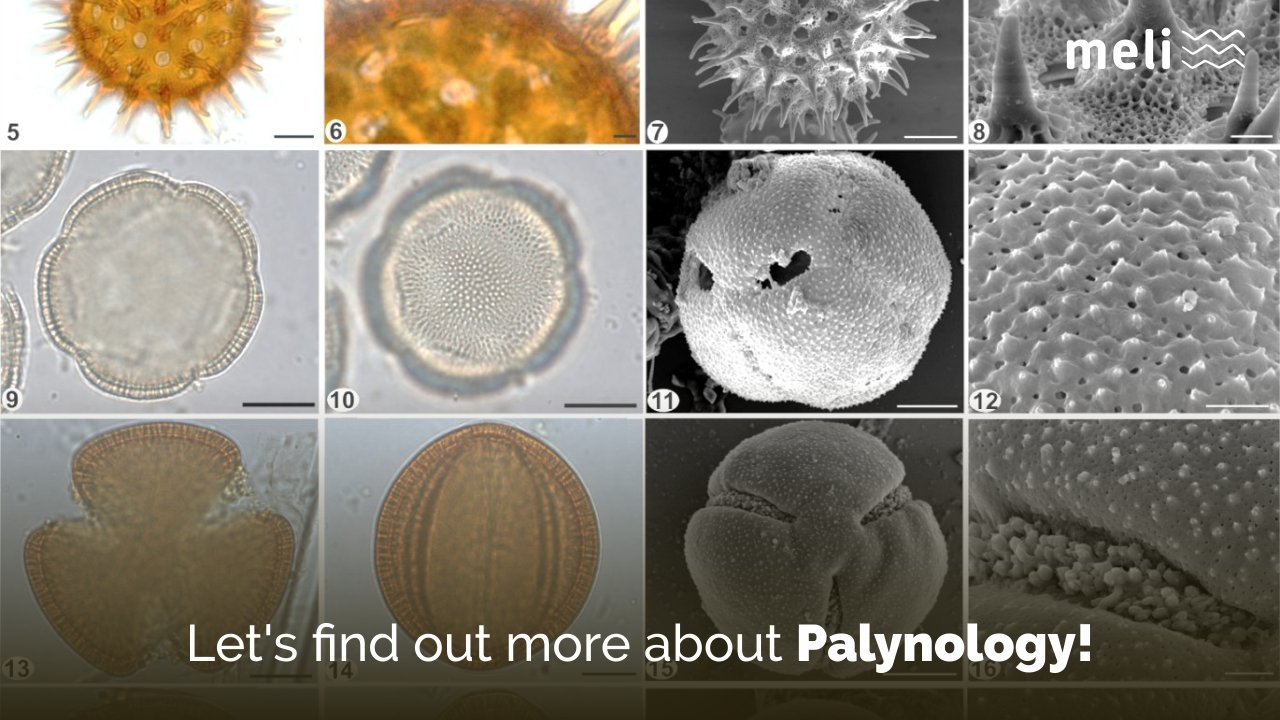The study of the pollen. Let’s learn about what interests the bees so much!
Leia em Português. Auf deutsch lesen.
Author: Luiza Romeiro.
First, it is important to know the origin of words. The word palynology is of Greek origin and means “fine mixture”, creating an analogy to the Latin term pollen, which means “fine flour”. With this in mind, we can already visualise the main object of study of the field of palynology and one of its main characteristics.
Studies on pollen grains began to evolve with the improvement in optical equipment starting in the 19th and 20th centuries, bearing in mind that until this time the microscopes used were rudimentary. Thus, research around pollen has become important in the identification of some families and genera of plants, in the discovery of allergies caused by pollen in humans, and in the recognition of pollen grains as an excellent fossil guide. This is possible because the exine, the outer layer of the pollen grain, is formed of sporopollenin, a substance with great chemical stability that provides structural resistance to the grains. Currently, the study of pollen grains has gone from a simple appendix of Plant Taxonomy to constitute a separate field of science, PALINOLOGY, which is still very new compared to other sciences (GASPARINO and CRUZBARROS, 2006).
Palynology is important due to its interdisciplinary nature and for presenting several different applications, being considered one of the most effective tools for the reconstitution of prehistoric environments (BARTH et al., 2010). According to Gasparino and Cruz-Barros (2006) palynology covers fields such as:
- Geopalinology – study of pollen and spores found in fossil and present-day sediments;
- Aeropalinology – study of pollen and spores present in the atmosphere, related or unrelated to cases of allergies in humans;
- Melissopalinology – study of apicultural or meliponistic pollen in honey samples;
- Paleopalynology – study of fossil pollen grains, spores, acritarae and chitinozoans found in insoluble residues resulting from physical and chemical treatments on sedimentary rocks;
- Copropalinology – study of pollen and spores present in animal faeces;
- Palynotaxonomy – taxonomic study of plants through pollen characteristics;
- Forensic palynology – study of plant pollen and spores associated with forensic biology;
- Entomopalinology – study of interactions between insects and plants.
Thus, palynology can be applied in several other fields of science such as paleoecology,
biostratigraphy, plant systematics, and archaeology (LIMA–RIBEIRO; BARBERRI, 2005).
One of the most used applications is “paleoecology” because pollen is the main protein resource used by bees (MICHENER, 1974). For this reason, the knowledge of the pollen types collected by them are extremely important and necessary for determining the relationships maintained with plants in a given area, establishing the productive potential, and the definition of management possibilities, considering that the variability of the flora allows for sustainable and profitable apiculture or meliponiculture (MARQUES et al., 2011). Moreover, from a more practical perspective, pollen analysis allows the standardization of honeys produced by apis mellifera and stingless bees and in the evaluation of honey quality (BARTH, 1989). And these data become essential due to the incentives directed to the development of meliponiculture and the possibility of honey commercialization (PINTO et al., 2012).
Visualization and consequently classification of the pollen grains is done using an optical microscope (CORREIA, 2016). However, scanning electron microscopy has already been used to obtain more detailed information about the pollen grain (QUINTA, 2013; SILVA et al., 2014). Since, Erdtman’s acetolysis (1952) is the most employed manipulation technique in this type of analysis during observation with optical microscopes. In this technique, an acid hydrolysis is performed on the pollen grains by using a mixture of acetic anhydride and sulfuric acid, seeking the exclusion of the cellular content, to simplify the observation and recognition of the morphological characteristics of the pollen grain, which are important in studies of plant systematics and phylogeny (MARTINS, 2010; OSTERKAMP; JASPER, 2013).
Last but not least, like all biological materials, pollen also has a collection which stores pollen data from reference mines, the so-called “palynoteque”. These are extremely important for any palynological study, contributing to research and projects in the most varied areas of palynology applications, such as supporting palynotaxonomic studies (EVALDT; PAZ; BAUERMANN, 2014; BAUERMANN; NEVES, 2005). Despite extensive contributions, there is still little investment in this type of collection when compared to others, and most of the time, palynoteques reflect regional floras on different levels (ABSY; RODRIGUES, 2013; NOVAIS et al, 2014).
Currently there are some websites offering digitized palynoteques, with photos and information on areas of study, which assist in the identification of pollen species and expand the knowledge about the varieties of morphological characteristics. Other available and supportive sources are books, atlases, and pollen catalogues. All this is essential for any study of the application of palynology. A new science, capable of contributing effectively and with excellence to the studies of biodiversity.
Your donation can have a positive impact on the world!
Subscribe to receive our Newsletter!
Find us also at Linkedin, Facebook, Twitter or Instagram
www.meli-bees.org
❤️


A palinologia é uma ciência incrível! Que honra ter aprendido muito sobre ela com a autora desta matéria! Parabéns pela belíssima apresentação, Luiza ❤